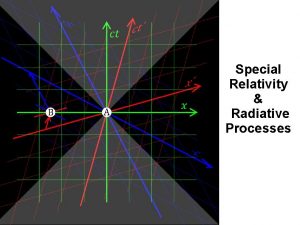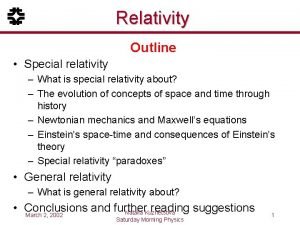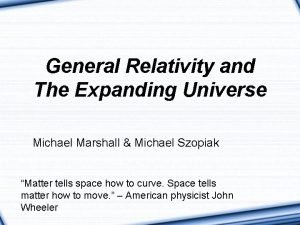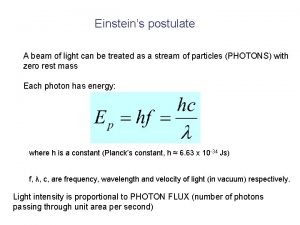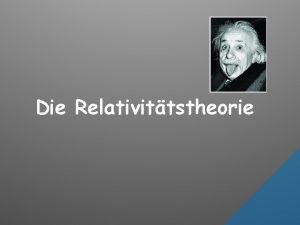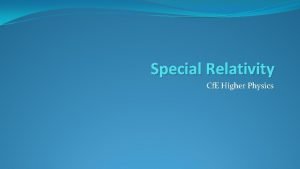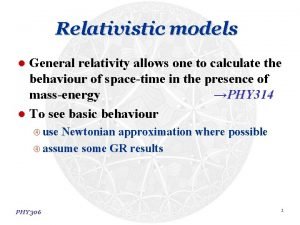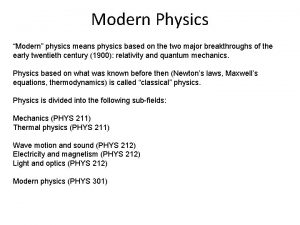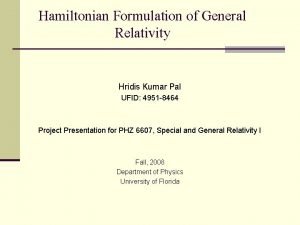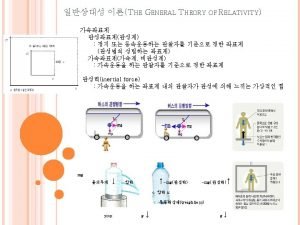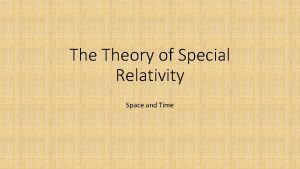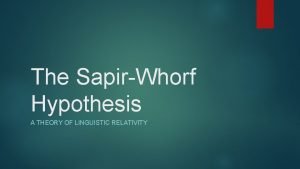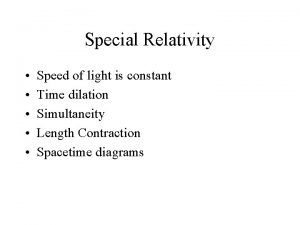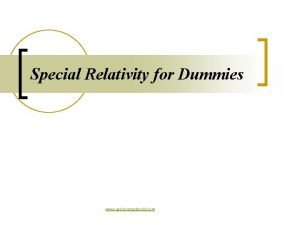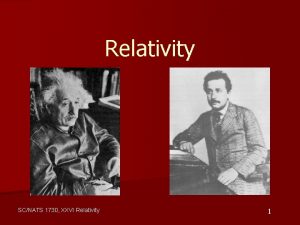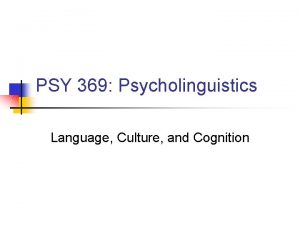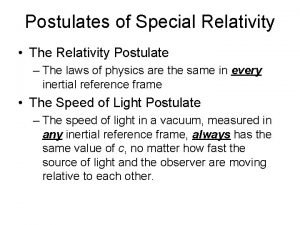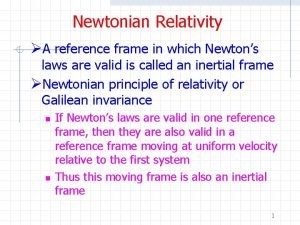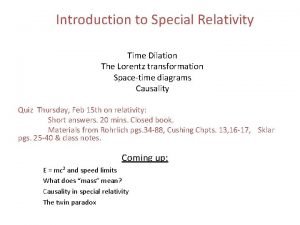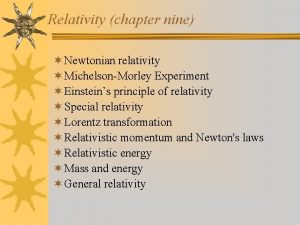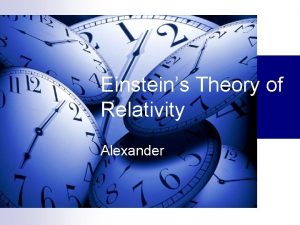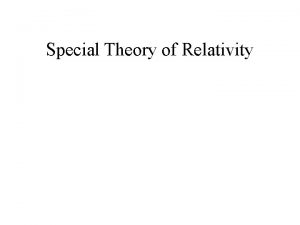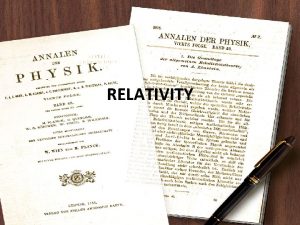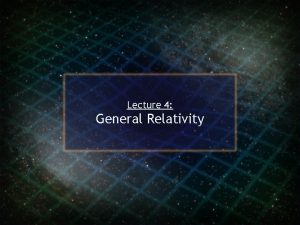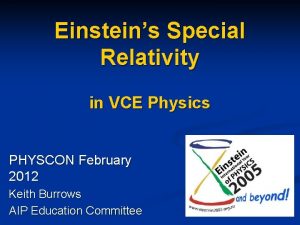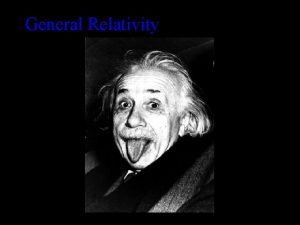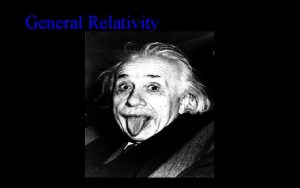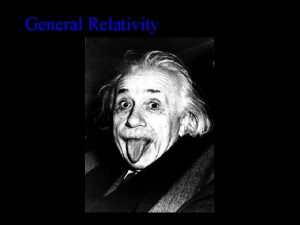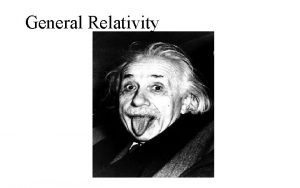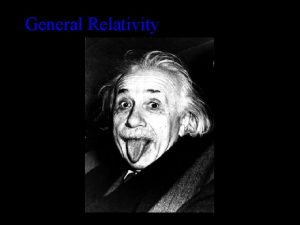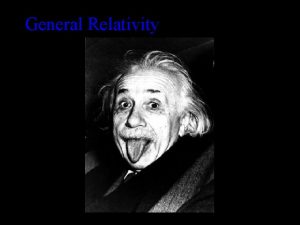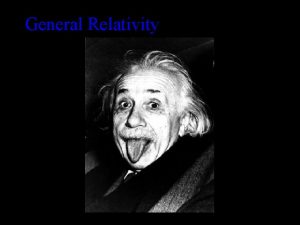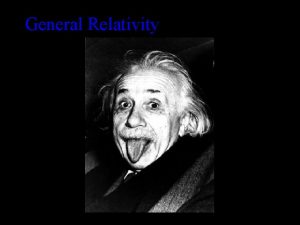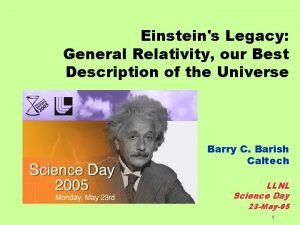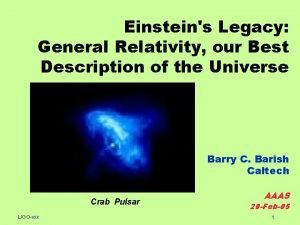Intro to General Relativity AH Physics Einsteins General




















- Slides: 20

Intro to General Relativity AH Physics

Einsteins General Theory of Relativity. �Albert Einstein's general theory of relativity is one of the towering achievements of 20 th-century physics. Published in 1916, it explains that we perceive as the force of gravity and the subsequent motion of the planets in fact arises from the curvature of space and time. Brian Greene

Frames of reference �In order to make any measurements involving motion in space and time, we have to define our frame of reference. This is the arena that we are making all our measurements relative to. �For example if we measure the speed of a train as it passes by a platform, then the platform (and hence the Earth) is the frame of reference and the speed of the train is measured relative to this frame. �This gets complicated when 2 observers are moving relative to each other. Each can claim to have their own frame of reference. Frames of reference 1. 1960's Frames of reference. mythbusters

Inertial Frames of Reference �A frame of reference that is stationary or moving at a steady speed in a straight line is called an inertial frame of reference �Einstein’s Special Theory of Relativity only applies to inertial frames of reference. �In fact Einstien’s 2 postulates for Special Relativity are: • The speed of light is the same for all freely moving observers • The laws of Physics are the same in all inertial frames of reference (in other words you cannot do an experiment to prove whether you are stationary or moving at a constant velocity. )

Non-inertial frames of reference �A non-inertial frame of reference is a frame which is accelerating i. e. accelerating in a straight line or moving in a circle �Einstein wanted to extend his work on Special Relativity to include noninertial frames of reference and as a result discovered the link between gravity and accelerated motion. This led him to his General Theory of Relativity

Einstein’s Happiest Thought - watch “Being in freefall in a gravitational field feels exactly the same as being stationary in outer space” “Being stationary in a gravitational field feels exactly the same as accelerating in outer space. ” “An observer in a closed box, such as an elevator or spaceship, cannot tell whether his weight is due to gravity or acceleration” Einstein called this “The Equivalence Principle” einstein-online

The Equivalence Principle An observer standing in a closed box could not tell the difference between being stationary on the Earth where the gravitational field strength is 9. 8 Nkg -1 or being in a spaceship that is accelerating in deep space at 9. 8 ms -2 Similarly being in freefall in a closed box feels exactly the same as floating in deep space! This led Einstein to the idea that gravity is not a force at all! - watch Brian Greene

Spacetime �Einstein considered that space and time are not separate. He combined the 3 dimensions of space with the time dimension and considered that the Universe exists in a “ 4 dimensional” arena called spacetime. �He reformulated Newton’s ideas of Gravity into a framework that states the gravity is the curvature of spacetime due to the presence of mass! (or in other words mass shapes the fabric of the Cosmos. (Deep…I know!)

Curvature of spacetime �Einstein imagined that the presence of mass warps the fabric of spacetime. This is often demonstrated using the “rubber sheet” analogy Einstein considered that Gravity is not a force, it is the warping of spacetime. Objects move and accelerate according to the shape of the curved space. watch

When is a circle not a circle…. . �Objects will naturally follow Newtons 1 st Law and continue at a steady speed in a straight line. �The curvature of spacetime means we perceive planets moving in circular orbits when in fact they are moving in straight lines in curved spacetime. watch �Think about the surface of the Earth, it is curved. A “straight line” on the 3 D surface of the Earth looks like a curve on a 2 D map. The shortest distance between two points in curved space is called a geodesic

Spacetime diagrams �Einstein used spacetime diagrams to help visualise motion through spacetime �One (or two) of the space dimensions is shown on the xaxis �Time is shown vertically on the yaxis

Worldlines on spacetime diagrams A worldline is a line on a spacetime diagram that shows the motion of an object through one (or two) dimensions of space and through time Constant velocity is a straight line A curve represents accelerated motion If the x-axis has units of light years and the yaxis has units of years then the speed of light is shown as a line at 45˚ It’s a bit like a displacement time graph with the axis reversed!

Worldline diagrams Draw a space time diagram to show the motion through spacetime of an object that is � a) stationary � b) moving at a steady speed well below the speed of light � c) travelling at the speed of light � d) accelerating � e) decelerating to zero.

Observable Effects of General Relativity – Time! �The greater the gravitational field strength, the greater the stretching of spacetime, clocks tick slower! �So clocks on the surface of the Earth will run slower than a clock at the top of Mount Everest. (or on a satellite) �Clocks on GPS satellites need to be adjusted to take account of GR. (They need to be slowed by 47 microseconds per day) �In regions of extreme gravitational fields, clocks will run noticeable slower �The most extreme gravitational fields in the Universe are in Black Holes. �The gravity (or to take Einstein’s viewpoint, the curvature of spacetime) is so great in a Black Hole that time stops at the event horizon. (There are equations for this that you may meet in an exam as Problem Solving. )

The slowing of time.

Gravitational lensing �A galaxy behind another galaxy can have its light “bent” by the gravitational distortion of spacetime of the closer galaxy. In this picture the blue light from a galaxy is bent into a ring by the large gravitational field of the closer yellow galaxy. This ring of light is known as an Einstein ring.

Gravitational waves Albert Einstein predicted the existence of gravitational waves in his general theory of relativity a century ago, and scientists have been attempting to detect them for 50 years. Einstein pictured these waves as ripples in the fabric of space-time produced by massive, accelerating bodies, such as black holes orbiting each other. These have now been detected on Earth using very sensitive laser apparatus LIGO Glasgow

Precession of Mercury (Research) A long-standing problem in the study of the Solar System was that the orbit of Mercury did not behave as required by Newton's equations. As it orbits the Sun, this planet follows an ellipse. . . but only approximately: it is found that the point of closest approach of Mercury to the sun does not always occur at the same place but that it slowly moves around the sun. This rotation of the orbit is called a precession. As seen from Earth the precession of Mercury's orbit is measured to be 5600 seconds of arc per century. Newton's equations, predicts a precession of 5557 seconds of arc per century. There is a discrepancy of 43 seconds of arc per century. This discrepancy cannot be accounted for using Newton's equations. In contrast, Einstein was able to predict, without any adjustments whatsoever, that the orbit of Mercury should precess by an extra 43 seconds of arc per century should the General Theory of Relativity be correct. � http: //physics. ucr. edu/~wudka/Physics 7/Notes_www/node 98. html

Black Holes Black holes distort spacetime so much that the laws of physics break down at the event horizon. Black holes create “holes” in the fabric of spacetime One current theory is that worm holes could exist between black holes that could in theory provide a mechanism to travel to other regions of the Universe instantaneously. (Crazy…I know!)

Further Reading �A Brief History of Time –Stephen Hawking �The Elegant Universe –Brian Greene �Why does E=mc 2 - Prof. Brian Cox Website : World Science U
 General relativity vs special relativity
General relativity vs special relativity General relativity vs special relativity
General relativity vs special relativity General relativity vs special relativity
General relativity vs special relativity De broglie hypothesis
De broglie hypothesis Einsteins postulate
Einsteins postulate Mythbusters relative velocity
Mythbusters relative velocity General relativity equation
General relativity equation Modern physics meaning
Modern physics meaning Hridis pal
Hridis pal General theory of relativity
General theory of relativity Theory of general relativity
Theory of general relativity Time dilation theory of relativity
Time dilation theory of relativity Sapir-whorf hypothesis definition
Sapir-whorf hypothesis definition Special relativity
Special relativity Relativity for dummies
Relativity for dummies Postulates of special theory of relativity
Postulates of special theory of relativity Relativity definition
Relativity definition Sapir whorf hypothesis
Sapir whorf hypothesis 2 postulates of special relativity
2 postulates of special relativity Newtonian relativity
Newtonian relativity The law of relativity
The law of relativity
